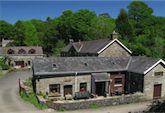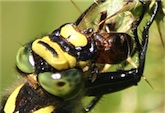The spectacular countryside that surrounds our holiday cottages is home to many species of butterfly, including many of the magnificent ‘aristocrats’. Great fun can be had trying to spot as many different types as possible during your holiday. The following images taken at Plas Farm feature many of the butterflies in Wales.


Small Tortoiseshell (Aglais urticae)
Often seen along the farm drive and around the buildings, male butterflies establish territories by driving off other butterflies from favourite patches in sunny situations, often next to a wall or a hedge. Each day they set up a territory about noon and during the afternoon each male will hold, on average, two areas, each for about 90 minutes.
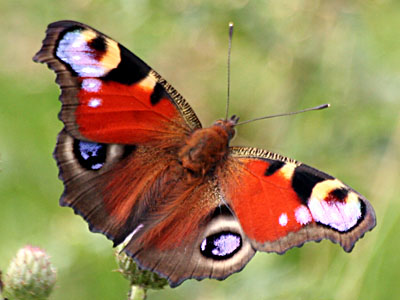
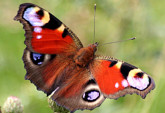
Peacock (Inachis io)
The four false eyes on the peacock's wings make it unmistakeable. It uses sound as well as its coloured false eyes to frighten away a predator such as a bird. As the predator approaches, the butterfly will open and close its wings rapidly, making a scraping noise as the wings rub together.
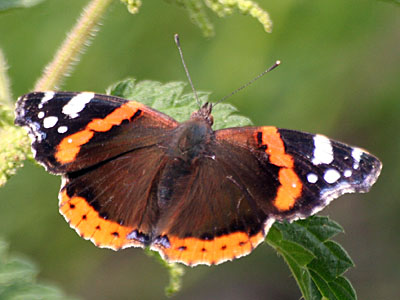
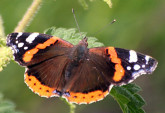
Red Admiral
The bright colours of the butterfly earned it the 18th-century name of the admirable, from which its modern name evolved. This picture was taken outside Bwthyn Y Sear holiday cottage, where one chose to rest and sun itself, displaying the brilliance of its outstretched wings.
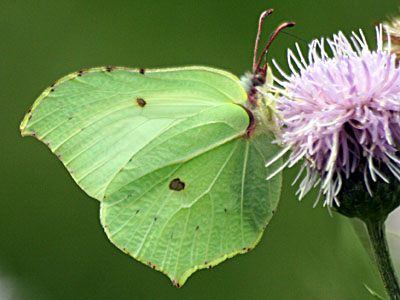
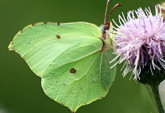
Brimstone (Gonepteryx rhamni)
The word butterfly was probably first used to describe this butter-coloured insect. "Butterfly" eventually came to include all species and the brimstone acquired its present name which relates to the colour of sulphur. This butterfly is a powerful flyer and is sometimes seen fluttering over the holiday cottages, looking for flowers from which to drink nectar. The shape and colour of its wings allows it to blend in with the surrounding vegetation.
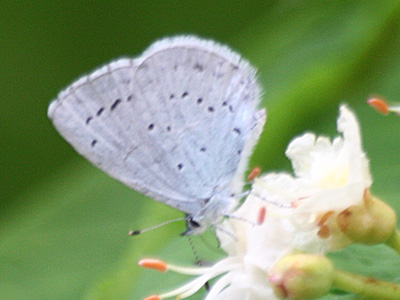

Holly Blue (Celastrina argiolus)
The Holly Blue is unique among British butterflies as its caterpillars have different food plants at different times of the year - holly in spring and ivy in the autumn. Holly trees in spring and ivy-bound trees and walls in summer attract this small butterfly. The one in the picture was spotted on the horse chestnut tree outside Bwthyn Y Saer holiday cottage.
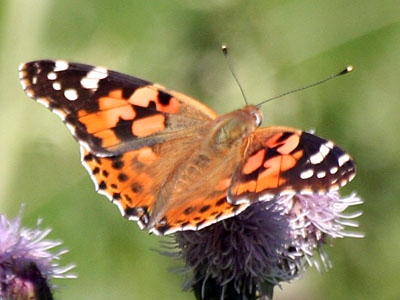
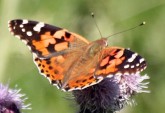
Painted Lady (Cynthia cardui)
Each May and June, painted ladies migrate to Wales from south-west Europe and North Africa, a distance of more than 800 miles (1,287 km). They travel at around 10 mph, skimming over meadows and hedgerows and by July may be spotted in the fields behind the holiday cottages, seeking out the nectar from meadow thistles whilst avoiding attacks from hungry Emperor dragonflies.
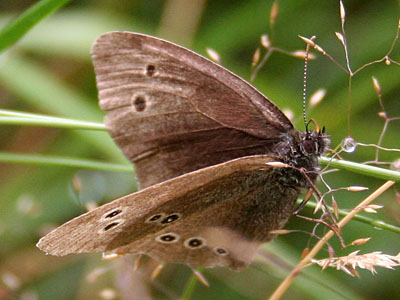
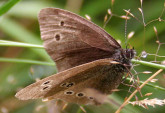
Ringlet (Aphantopus hyperantus)
The ringlet is the only British butterfly with so many prominent false eyes on the underside of both fore-wing and hind-wing. It loves wet grassy places and in keeping with its dull colouring, it even flies on dull days. With a life span of two weeks, I suppose it can't afford to be too choosy. This picture was taken on the rushy hillside pasture behind the holiday cottages. It is widespread in southern Britain apart from the London area where is completely absent.
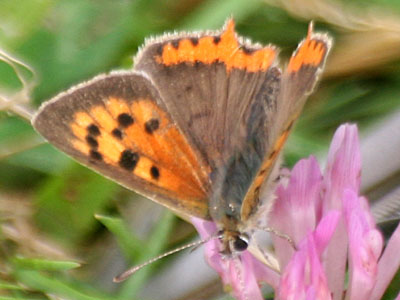
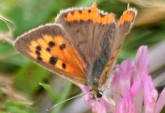
Small Copper (Lycaena phlaeas)
The caterpillar of this butterfly eats a variety of common dock and sorrel species which live at the farm. It is always found near flowers and can be seen darting around to intercept other butterflies that fly into its territory. This species is the sole remaining member of the British coppers. This picture was taken at the edge of some woodland on the hillside at Plas Farm.
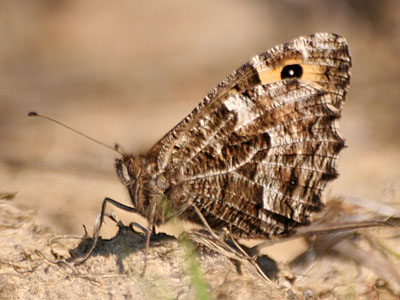
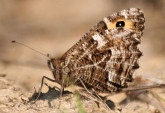
Grayling (Hipparchia semele)
To see Wales's largest brown butterfly, you will need to make the 45 minute hike from your holiday cottage to the top of Mynnydd Marchywel mountain where you are likely to find it settled on stony or earthy ground. It rarely visits wild flowers for nectar and is believed to drink sap from oak and pine trees. It lands after a short flight, retracts its wings and tilts over sideways to the sun so as not to cast an obvious shadow. This butterfly is relatively uncommon and is restricted to the coastal regions of Britain. As an aside, I have discovered that this butterfly seems to enjoy landing on people - especially those wearing blue jeans.
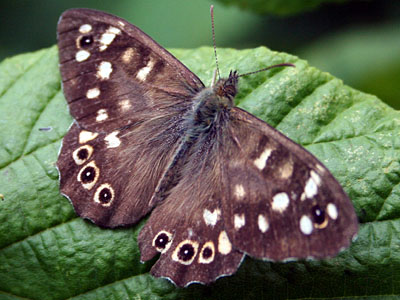
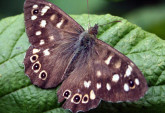
Speckled Wood (Pararge aegeria)
Resident to southern Britain, you will find this butterfly if you take a short walk from your holiday cottage to the woods where you will find them in sunny glades, which they defend and conduct their courtship. Their speckled wings give an ideal camouflage in the dappled world of light and dark where sunlight percolates through the canopy and scatters over brambles and honeysuckle.

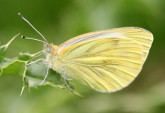
Green Veined White (Pieris napi)
Similar to the small white but with veins under the wings picked out in streaks of green-black scales. Males exude a strong scent of lemon verbena, probably used in courting.
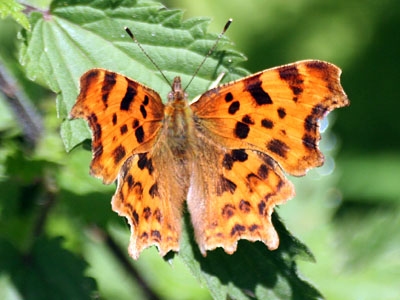
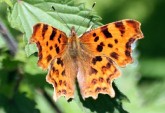
Comma (Polygonia c-album)
The comma is the only Welsh butterfly with wings that give the appearance of ragged edges - an aid to camouflage. The underside of its wings has a distinct white 'comma' mark. This spectacular aristocrat delights in sunshine and will bask for hours with wings spread, often within yards of your holiday cottage. Absent from large areas of northern Britain, the comma is increasing in population for reasons that are not fully understood. Oh, and look out for their caterpillars on the leaves of elm trees - they look like bird droppings!

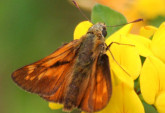
Large Skipper (Ochlodes venata)
The largest of the British skippers, the male has a dark bar (the scent scales) in the centre of the forewing. This picture was taken in the rush pasture on the hill behind the holiday cottages one sunny day in July.
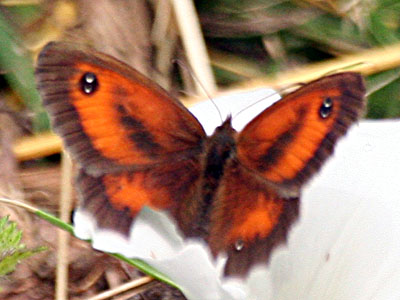
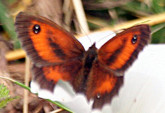
Gatekeeper (Pyronia tithonus)
Often found in the corners of fields near bramble thickets, the orange-brown gatekeeper has false eyes on its forewings which usually have two white pupils. This specimen is a female as it has a distinct dark band of scent scales across its forewings.
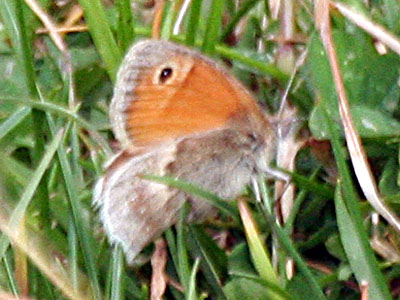
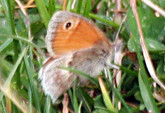
Small Heath (Coenonympha pamphilus)
The small heath is very common throughout Wales and may be seen in many of the fields at Plas Farm. The higher up the hill you walk, the more likely you are to find this little butterfly - often just resting on a piece of grass.
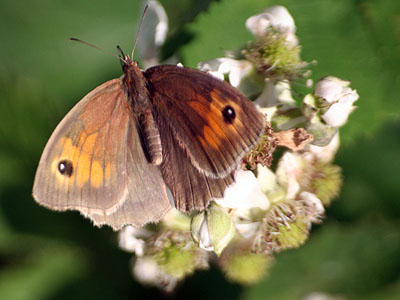
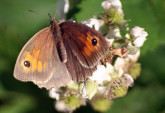
Meadow Brown (Maniola jurtina)
(Female) Wales's commonest butterfly is the meadow brown which may be spotted in all the fields, feeding on grass. The female is brighter than the male - an unusual feature as male butterflies are normally the more colourful. The large false eyes on its forewings serve confuse predatory birds about the position of the body, giving the butterfly a greater chance of survival. Meadow Browns are always on the wing on sunny days in the fields around the cottages but unlike many other butterflies they will fly on dull days, and even in drizzle. In spite of their false eyes, they are often caught and eaten by birds.
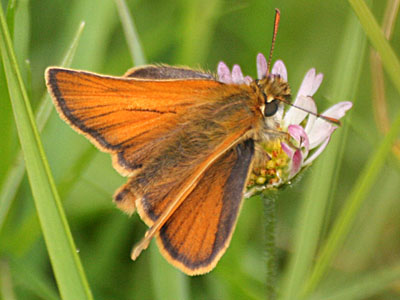
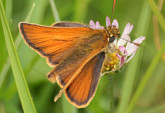
Small Skipper (Thymelicus sylvestris)
Widespread in Wales but absent from Ireland, Scotland and northern England, the small skipper may be found at Plas Farm during the summer, darting among flowers in the grassy meadows behind the holiday cottages. They drink the nectar from the flowers and use the tall grasses as vantage points from which to conduct sorties against other insects that trespass on their territory. When they are resting, they sometimes hold their hind wings slightly backward - like a swing-aircraft - and sometimes incline their forewings upwards.
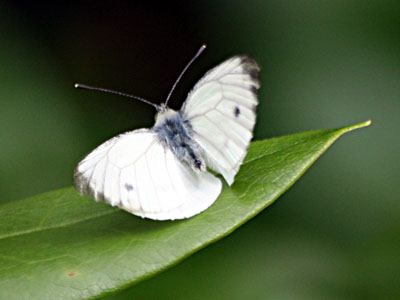
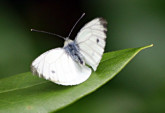
Small White (Pieris rapae)
The small white is the second most common butterfly in Wales. Its fore-wings have black tips, with one black spot on the males and two on the females. Their caterpillars' food plants, wild and cultivated members of the cabbage family, grow almost everywhere, so small whites are seen throughout Britain.
